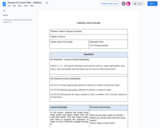
Using the robot, Dash, students will program him to land on different numbers in order to make a specific total.
- Subject:
- Mathematics
- STEM
- Material Type:
- Activity/Lab
- Author:
- Glenn Shelton
- Carrie Robledo
- Date Added:
- 03/30/2020

Using the robot, Dash, students will program him to land on different numbers in order to make a specific total.

As students are reviewing odd and even numbers, students first sketch out a bug that has odd or even features. Students then use Tinkercad to turn their sketch into a 3D design to be printed.

The class won a good behavior contest and the reward is a bowling party. The day of the party it is raining and the students are unable to visit the bowling alley. So the students build their own bowling alley using the WeDo robot kit. Then they have a bowling competition to see who bowls the highest score.

Students will use engineering materials to create a topographic map then program Sphero to be a tour guide through the map.

Design and build a sleigh using a WeDo kit, K’nex or similar, that will pull a specific measured weight.

As students study electricity and circuits, they can build their Operation games. Made from a few household materials, a makey-makey kit and the Scratch website, students can create and play their Operation game.

Students will create a fictitious city that has experienced a natural disaster. Once their city is completed, students will create a vehicle to transport supplies to the people who need help.

After learning about Gail Halvorsen, the World War II pilot who created tiny parachutes from handkerchiefs and string to deliver chocolates and other candy to the children of Berlin, students will engineer parachutes to deliver their own packages using Parrot Mambo Drones.

Students will be given a Makey Makey kit, a Chromebook with the Scratch website and a choice of materials to create a circuit that will allow the students to play an in instrument.

As students study the human body, they can include the different body systems as they build their Operation games. Made from a few household materials, a makey-makey kit and the Scratch website, students can create and play their Operation game.

Each team has a budget of $45 to spend to modify a cup into the ultimate predator. After predators are constructed, students battle to pop each others’ balloons. Whichever predator is able to survive is the apex predator.

Students will use Lego WeDo kits or any other building kit such as k’nex, or geomags or craft materials to build the alligator or alligator mouth and then use a protractor to measure the angle of the mouth opening. Connecting math and the everyday world through the use of building an object to incorporate angle measurements. As an extension of learning students will then attempt to vary the measurement by adjusting the bands or speed of the motor if using wedo or programmable build kits or non-robotic version by adjusting the hinge of the mouth. Students should attempt to alter the build in efforts to change the angle.

During this PBL, students will read a text and make it come alive by creating a 3D story map that shows the major events of the plot and the obstacles that the main character faced throughout the story. Students will then code an Ozobot to maneuver through the story and the obstacles while explaining them to an audience or their peers.

After brainstorming a list of essential businesses and/or points of interest, each student will create a building from recycled cardboard. They will then decide a location to house the building in the city. There will also be waterways included. Then in teams of 2-3 the students will use recycled materials to build a bridge to carry the ozobot through the city giving tours of important locations. The ozobot will need to be able to cross the bridge which will allow students to work through issues with force and motion.

In this lesson, students will review living thing needs and places where they can meet their needs. They will create a maze and learn to program the sequence of steps to have a Bee-Bot navigate through it.

Students are tasked with moving a 20 gram (or other low denomination) weight a distance of one meter using a “Sphero*” remote controlled robot. Students use available materials to design and build a structure that will allow the sphero to push or pull the weight, while allowing for factors such as friction, direction, and gravity. *Note: Although students can issue specific commands in the Sphero software, this activity only requires that they be able to “drive” the Sphero, thus providing the force to move the weight.

During this unit, students will learn about the Great Pacific Garbage Patch. They will read about the GPGP and then prepare a presentation with their findings and solutions. Lastly, they will create a prototype to help with the ocean cleanup and use Spheros to maneuver the prototype to pick up trash in water.

K-2 students will learn basic technology terms with a scavenger hunt and games!

Students will create an obstacle course for the Dash robot to demonstrate the following movements and position words: straight, in front of, behind, zigzag, between, on top of, round and round , under, above, back and forth, below, beside, fast and slow.

OKAQ